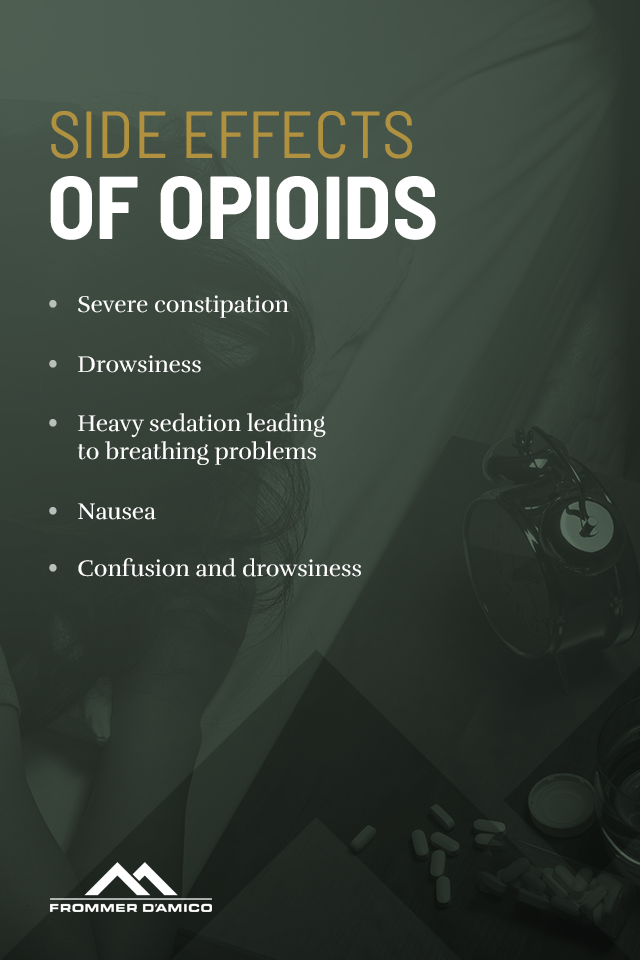The opioid addiction crisis has become one of the most devastating and dangerous healthcare emergencies in the United States in generations. Many states have declared a state of emergency to prevent opioid overdose deaths. Court cases involving drug companies that have both pushed the use of opioids and then also pushed the use of drugs that help the opioid crisis have been much in the news. States like Pennsylvania have issued special guidelines with suggestions about how doctors should prescribe opioid drugs.
Some of these new guidelines in Pennsylvania are aimed at the workers’ compensation system, which has seen a dramatic rise in the increase of opioid prescriptions for pain relief over the past several years. Injured workers in Pennsylvania have seen the rates of opioid addiction rise as the number of opioid prescriptions has also risen.
Understanding Opioid Addiction
To understand the opioid addiction crisis, we need to look at the increase in the number of opioid prescriptions nationally. Despite a lack of research and evidence about the long-term benefits of opioids, there has been a dramatic increase in the use of opioids to treat conditions such as osteoarthritis and back pain. In the past, doctors used opioids largely to help cancer patients deal with chronic pain.
Opioids became a problem when doctors began prescribing them for chronic, non-cancer related pain:
- In 2017, more than 191 million prescriptions for opioid medications were given to Americans.
- The number of prescriptions varies widely from state to state. In Alabama, the state with the highest prescription rate, physicians wrote three times as many prescriptions per person as physicians did in Hawaii, which has the lowest prescription rate.
- Why doctors have been prescribing opioid medications so much is still unknown since studies show that the variation in the use of opioids does not seem to be explained by the health status of people in different regions.
- In 2016, there were 64,000 opioid overdose deaths in the United States.
- Prescription drugs involved most often in opioid deaths are OxyContin, methadone and Vicodin.
- The misuse of opioid prescription drugs is widespread. More than 11.5 million Americans reported that they had misused prescription opioids in 2016.
- Opioid overdose deaths seem related to the use of other drugs as well, especially benzodiazepines such as Xanax, Valium or Ativan. These drugs help induce sleep, relieve anxiety or prevent seizures and are linked to opioid deaths. Often these drugs, which depress the central nervous system, affect a patient’s breathing when combined with an opioid. Patients should never take opioids and benzodiazepines at the same time.
Opioid Addiction in Pennsylvania
While preliminary data shows some signs that the opioid crisis in Pennsylvania has slightly improved, the situation is still fraught with peril:
- Physicians in Pennsylvania wrote almost 58 opioid prescriptions for every 100 people in 2017. The U.S. rate is 59 prescriptions. The good news is that this represents a 30% drop from the 83 prescriptions per 100 people that doctors prescribed in 2012.
- The age-adjusted rate of drug overdose deaths increased by almost 17% in 2017 in Pennsylvania, going from 38 per 100,000 in 2016 to 44 per 100,000 in 2017.
- Although opioid deaths are not counted separately in the overall drug overdose death total, physicians and state officials are aware that opioids caused the majority of these deaths.
- The state does have more solid figures for 2016. There were 4,642 opioid overdose deaths in that year. This meant that about 13 people a day were dying from opioid overdoses in Pennsylvania. This was a 37% increase over the number of opioid overdose deaths in 2015.
- The 2019 state administration in Pennsylvania described the opioid overdose situation as the worst public health crisis in the state in a generation.
- The opioid overdose epidemic in Pennsylvania has affected families, the workplace and the economy, the criminal justice system and other health-related issues. Some of these issues include infants born with opioid withdrawal because their mothers were addicted to opioids and the impact of HIV and hepatitis C treatments for people on Medicare.
Opioids and Workers’ Compensation
The opioid epidemic has affected workers’ compensation systems across the United States. According to some estimates, the use of opioids to deal with the pain associated with work-related injuries has dramatically increased:
- Of all the drugs that doctors subscribe for pain in workers’ compensation cases, almost 70% are opioids.
- This total represents about one-third of all the drugs prescribed in workers’ compensation cases.
- One of the main concerns of overprescribing opioids is that injured workers using opioids may develop tolerance to the drug, which means that they need to use a higher dose to deal with pain. This leads to the use of more and more opioids as the injured worker heals.
- The use of opioids to deal with an injured worker’s pain has had one of the most profound effects on the cost of workers’ compensation claims in the country.
- Injured workers in Pennsylvania have one of the highest rates of long-term opioid use in the United States, according to the Workers’ Compensation Research Institute (WCRI).
- Additional research showed that when physicians prescribe opioids for lower back injuries, patients had a substantially longer period of temporary disability.
- When an injured worker in Pennsylvania uses opioids, the average time-loss claim is 900% higher than it is for injured workers who are not taking opioids.
1. When Are Opioids Prescribed for an Injured Worker?
In the past, doctors prescribed opioids primarily to help cancer patients deal with chronic, long-lasting and severe pain. The number of opioid deaths began to rise in 1991 after an increase in opioid prescriptions. Pharmaceutical companies and medical societies played a significant role in the increase in the number of opioid prescriptions being written. These organizations said that there was a low risk of addiction to prescription opioids.
Pharmaceutical companies also began to recommend opioids for the use of non-cancer related pain about this time. By 1999, 86% of patients being prescribed opioids were dealing with non-cancer related pain.
This also led to an increase in opioid prescriptions for injured workers. University researchers found that opposition to restricting opioid prescriptions was “significantly more common” with organizations that receive funding from drug manufacturers. Meanwhile, the Senate Committee on Homeland Security and Governmental Affairs detailed the extensive financial ties existing between opioid manufacturers, third-party advocacy organizations and professional medical societies.
A 2018 study by the WCRI found that injured workers who were likely to be prescribed opioids were:
- Aged 55 years or older
- Employed by smaller companies
- Working in counties where more people have health insurance
Additionally, workers injured in the mining industry were more likely to be prescribed opioids than any other industry. Injured workers who live in communities with less than 20,000 inhabitants and were prescribed opioids at 68% of the time, while workers who suffered fractures and were prescribed opioids 79% of the time. Men were prescribed opioids 46% of the time, and women were prescribed opioids 42% of the time.
2. What Opioids Are Regulated?
Most states are developing new guidelines to determine how opioids should be regulated and prescribed. It’s not always an easy solution. For instance, in a 2018 Federal Drug Administration (FDA) meeting held in Silver Spring, Maryland to discuss how the FDA can better regulate opioids, the meeting evolved into a showdown between two different camps. On one side were the patients suffering from severe and chronic pain, who want less regulation and argued that government regulation was driving more people who need pain relief towards drugs like heroin. On the other were those who have lost loved ones to opioid drug overdoses, who were calling for increased regulation.
While the federal administration has declared the opioid crisis a national health epidemic, federal regulations lag behind what most states are attempting to do.
How Long Should Opioids Be Prescribed?
Physicians prescribed opioids for pain relief because they believe they work. Questions surrounding opioid prescriptions, however, deal with how effective opioids are in the long term and if continuing to prescribe injured workers opioids only increases their tolerance towards the drug, which can lead to addiction and even death.
1. Benefits of Opioid Prescription
Opioids can be powerful pain relievers, but they aren’t without risk. Patients prescribed opioids have described success with pain relief in the short-term, according to studies, but doctors should not prescribe opioids for longer than 12 weeks.
According to the Centers for Disease Control (CDC), physicians should prescribe opioids only when other methods to control pain have failed and when the benefits and pain reduction outweigh the risks of addiction.
2. Dangers of Opioid Prescriptions
One of the main problems with prescribing opioids is that very little research has been done on their long-term effectiveness. Patients prescribed opioids over long periods have shown a tendency to develop a tolerance towards the drug’s effects, which means that they need to increase the amount of opioids to gain the same amount of pain relief as in the past. Additionally, when opioids are used in connection with other drugs, they can be more likely to lead to overdoses and death.
Other side effects of opioids include:
- Severe constipation
- Drowsiness
- Heavy sedation leading to breathing problems
- Nausea
- Confusion and drowsiness
3. How Long Should I Take Opioids?
There are no straightforward answers for how long someone should take opioids. However, opioids are highly addictive, and the likelihood of becoming dependent increases after just five days. The CDC recommends patients and their doctors reevaluate the benefits of using opioids as soon as one week after starting treatment and at least once every three months if treatment continues. Treatment should not continue for longer than 12 weeks.
Always discuss the risks and potential benefits of using opioids with your doctor.
What Are the CDC Guidelines?
The CDC guidelines for prescribing opioids to deal with chronic pain are designed to improve how these drugs are used and provide patients with safer, more effective treatment of chronic pain. These guidelines recommend:
- Before a patient begins any use of an opioid to deal with chronic pain, they should discuss the risks and possible benefits of using opioids with their physician.
- That both the patient and the doctor be responsible for managing this therapy.
- That patients and physicians should evaluate the benefits of using opioid therapy within 1 to 4 weeks of starting and that they should do so at least once every three months if the treatment continues.
- The CDC guidelines suggest that a physician should only continue to prescribe opioids if it produces at least a 30% improvement in pain management.
These guidelines, when combined with the guidelines recommended for prescribing opioids for injured workers in Pennsylvania, provide a method of making sure that patients do receive safe treatment that helps to relieve chronic pain without addiction.
1. What Is Different in Pennsylvania?
In 2018, Pennsylvania released a new set of guidelines for prescribing opioid use, including guidelines specifically for workers’ compensation cases. These guidelines were designed to work with existing guidelines and to provide injured workers with quality health care. These guidelines should not reduce the judgment of physicians in deciding what prescriptions are necessary and should help ensure injured workers have sufficient pain relief to promote functional improvement. These guidelines were designed only to be used for treating pain not associated with cancer, sickle cell anemia or any terminal illness.
These new guidelines recommend:
- The use of over-the-counter non-opioid medications for the treatment of a self-limiting injury such as a sprain, a strain or a contusion.
- That when these types of injuries are more severe, muscle relaxants, such as cyclobenzaprine, tizanidine and baclofen, should be used to supplement pain management for an injured worker. These prescriptions should be limited to one week and only refilled for one additional week if the physician believes they have been effective.
- To treat acute pain, other non-opioid medications, such as gabapentin, can be used. Other treatments include rest, ice, physical therapy, cognitive-behavior therapy and exercise.
- If opioids are needed to treat chronic, intense pain, a physician should only prescribe the smallest dose they believe to be effective and for a short duration. If additional prescriptions are needed, they should only be issued for seven days, and patients prescribed opioids should be screened for substance abuse disorder.
- Doctors in the emergency room of a hospital should only prescribe opioids for an injured worker for three days and only if they are clearly needed.
- Since very little research exists about the long-term effectiveness of opioids, physicians should only continue to use opioids if patients show meaningful improvements in pain management.
If You Have Questions About Your Prescriptions or On-the-Job Injuries, Contact Frommer D’Amico
If your doctor has prescribed opioids to help you deal with the pain you have suffered from a work-related injury, make sure you discuss the benefits and possible harmful effects of beginning opioid therapy. Be a good consumer.
If you have any questions about whether or not your employer and their insurance company will provide you with the proper medications that you need when you file a workers’ compensation claim, you should contact the experienced attorneys at Frommer D’Amico.
We are a firm totally dedicated to workers’ compensation cases. It is our goal to help injured workers receive the benefits to which they are entitled. If you have any questions involving a workers’ compensation claim, or if you’ve been hurt on the job and you’re not sure how to go forward, give us a call. We offer a free evaluation, and we do not charge consultation fees or case management fees.
You can call us at 717-400-1000 or visit our contact us page to tell us how to get a hold of you and leave some information about your situation. A member of our team will get back to you as soon as possible.





